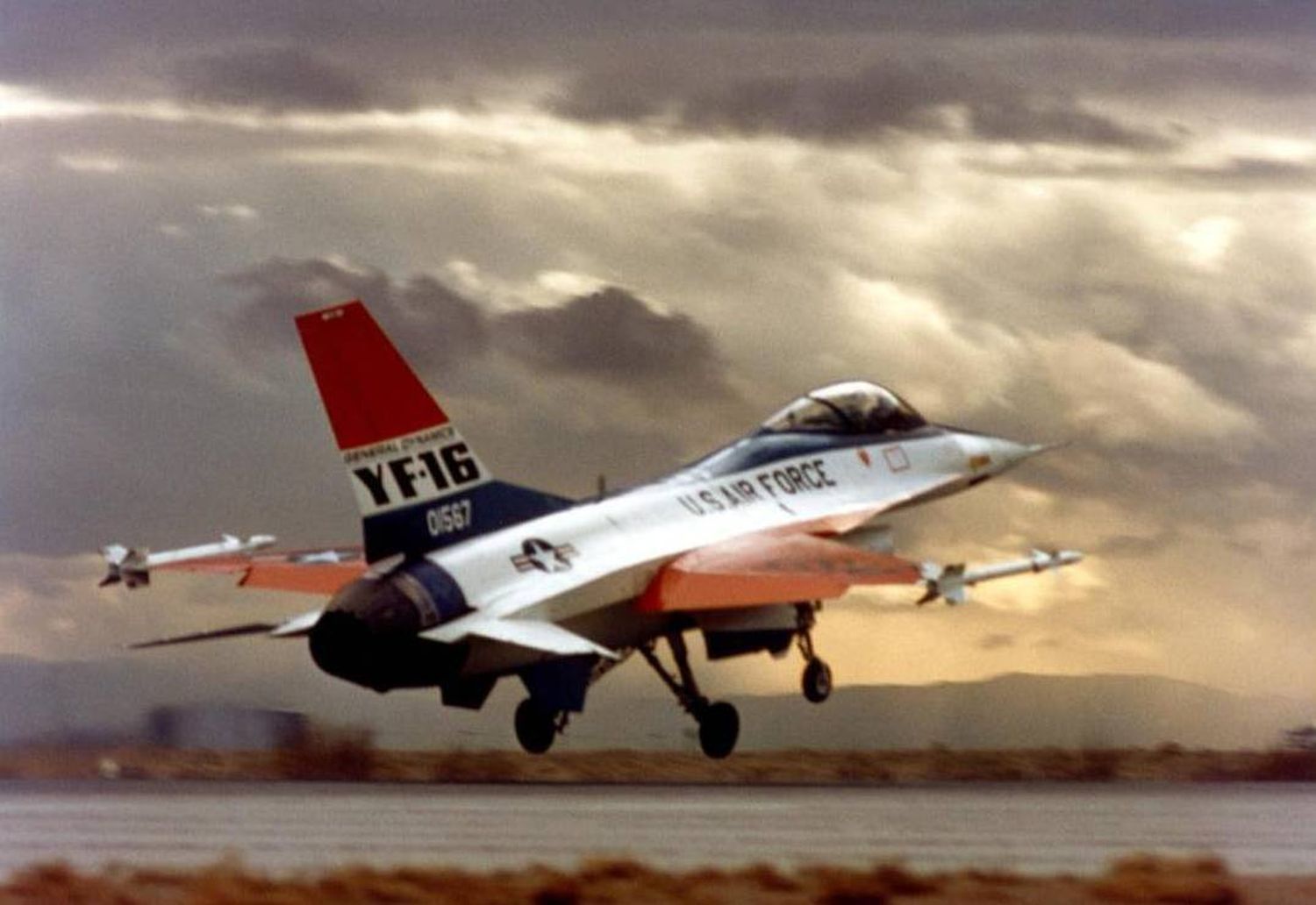50th anniversary of the first flight of the F-16, one of the most successful fighter jets of all time
On January 20, 1974, the first (unofficial and accidental) flight of one of the most successful fighter aircraft in history, the legendary F-16 Fighting Falcon, took place.
The YF-16 prototype, developed by General Dynamics for the U.S. Air Force LWF (Light Weight Fighter) competition, was at Edwards Air Force Base, 50 years ago, undergoing high-speed taxi tests. At the controls was pilot Phil Oestricher, who had the difficult mission of testing the capabilities of a new aircraft model that included several novel technological developments, such as the Fly-by-wire (FBW) computer assisted flight system or the sidestick, with which he was not familiar, which led him to make one of the most fortunate failures in history. The first «official» flight occurred on February 2 of that same year.
As the YF-16 prototype was speeding down the runway at 222 km/h, it began to oscillate violently due to the high sensitivity of the flight system to the test pilot’s commands. Knowing he had only seconds to avoid disaster, Phil Oestricher decided to give the engine more power and soar to the relative safety of the sky. With the aircraft under control, he orbited the runway and was able to land safely.
The first flight of the F-16, told by one of its protagonists
John G. Williams, structural flight test engineer on the YF-16 recalled that moment:
“During the first high-speed taxi test, a violent lateral oscillation had set in as a direct result of pilot-commanded oscillations (several maximum left/right commands) as the airplane reached rotation speed (~120 kt). Remember, this was the first airplane to have a fixed stick, and there was no opportunity for Phil to gain any feel for the airplane, until that high-speed taxi test. As the nose of the aircraft rose, the tailplane inadvertently scraped on the runway. The left wingtip missile and the right tail static probe also lightly contacted the runway. Phil chose to take off because the bird had begun to veer off to the left side of the runway, and he was faced with plowing through the desert or flying. Thankfully he chose to fly and possibly saved the entire program. After take off, Phil regained control and stayed up for six minutes, and landed uneventfully. Prior to the next flight, the stick sensitivity was reduced by 50% with gear down. Later, after complaints of not enough sensitivity, it was returned to the original.»
Fighter Mafia light fighter
Conceived in the early 1970s by a small but committed group of engineers and defense analysts known as the Fighter Mafia, the F-16 was designed as an alternative to increasingly heavy and unmaneuverable fighter aircraft.
A team working at General Dynamics’ aerospace division in Fort Worth, Texas (which Lockheed would acquire in 1993) was designing a new type of fighter to meet the ambitious goals of the Lightweight Fighter Mafia team. They set out to trade excess weight and heavy loads for speed and maneuverability, to develop a simple, inexpensive fighter that would fly so fast and turn so tightly that adversaries couldn’t stand a chance in a «dogfight.»

The F-16 design team translated those ideas into the most advanced combat aircraft of its day, leaning on new technologies that had never before been integrated into a single aircraft. Its smooth blended-wing body provided extra lift and control; its critical fly-by-wire system kept the design stable and increased its agility; and its slightly tilted back ejection seat, side-mounted control stick, head-up display and bubble canopy improved pilot survivability as well as visibility and control.
It was sleek and fast, but by the 1980s, the F-16 had to take on more missions, such as bombing ground targets and close air support. So Fort Worth engineers added more powerful weapons and targeting systems without diminishing the F-16’s unmatched agility, transforming the Falcon into a true multi-role fighter and the quintessential «workhorse» of the NATO Air Force and a resounding export success.
50 years of undisputed success
Since its first production order in 1975, more than 4,500 F-16s have been produced for 26 nations around the world. Today, 3,100 F-16 fighters operate in the Air Forces of 25 countries. They participated in several wars and countless armed conflicts, during which they flew 13 million sorties, collectively accumulating 19.5 million flight hours. Fifty years after its first flight, the F-16 is still in production at the modern Block 70/72, with orders for 135 aircraft for six countries, and more orders are expected to come in the future.

This data speaks to the success of the F-16 design, which began as a small, low-cost air-to-air fighter and evolved into an advanced and powerful multi-role combat platform that was always up to the task of meeting the most demanding circumstances. On the front line for nearly 50 years, no one can argue that the F-16 has aged exceptionally well.


Comentarios
Para comentar, debés estar registrado
Por favor, iniciá sesión